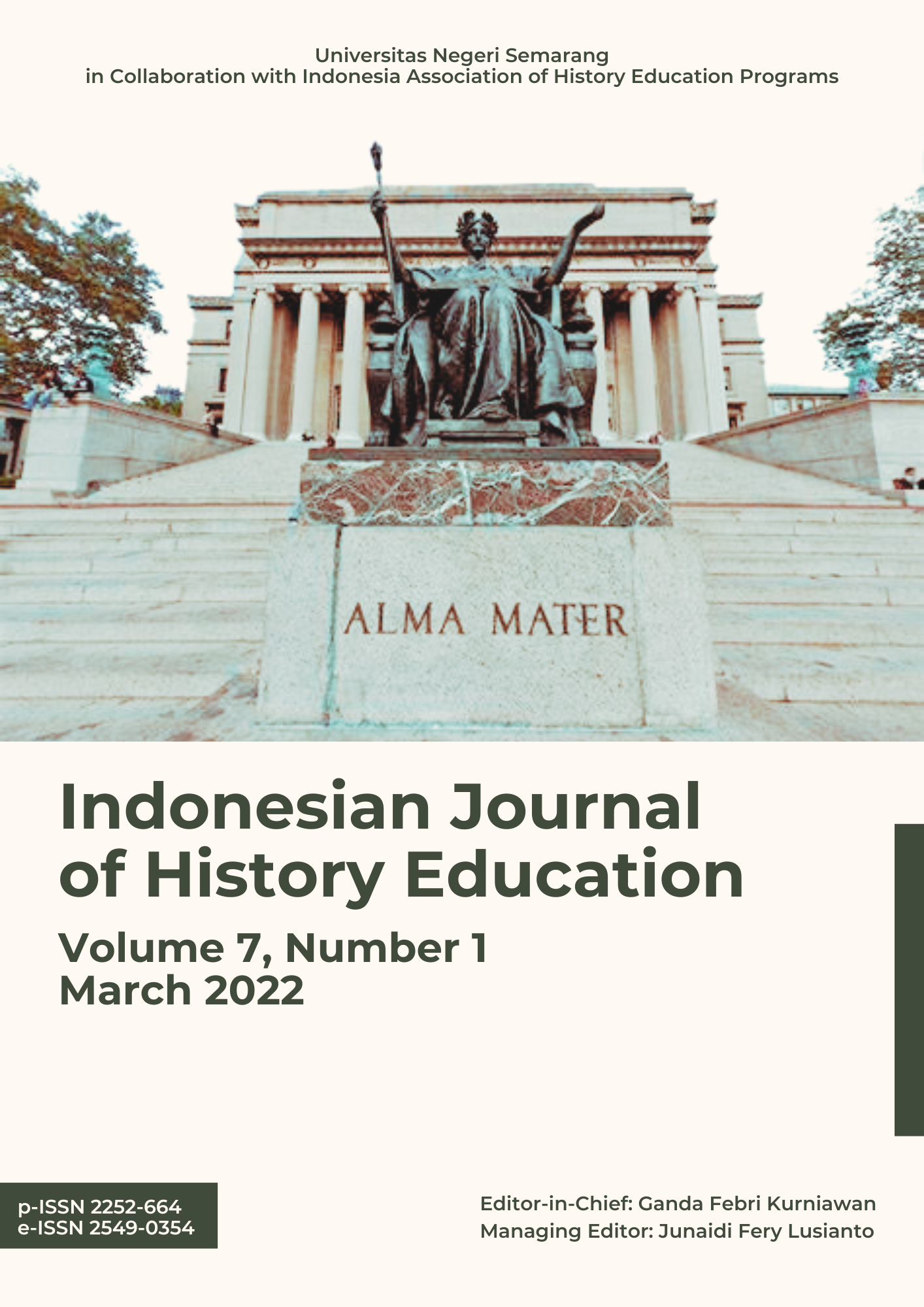The Construction of Historical Empathy in Learning History with a Global Diversity Perspective
Abstract
The purpose of the research was to find out the implementation of historical learning of the national movement, to find out the perceptions of Chinese students on historical learning of national movements and to find out the obstacles in historical learning of the national movement in Wonosobo Christian High School. The researchers used qualitative research methods. The data sources of this research are informants, documents and others data. The data collection techniques used observation, interviews, and documentation. The data analysis technique used is data analysis techniques with interactive models including data reduction, data presentation, inference, and verification. The implementation of historical learning on the subject of national movements carried out through the planning and implementation stages. In planning stage the teacher are prepares leasson plan, the media, learning methods in from of group discussions and learning material. The perception Chinese student of learning history of national movements are differing one another. This is caused by internal factors and external factors that influence their perception of historical learning, the subject of the national movement. In learning the history of the subject of the national movement, chinese students have their own obstacles. Regarding the status of Chinese ethnic students does not become a barrier to learning because high tolerance at the school.
References
Ahmad, T. A. (2014). Kendala Guru Dalam Internalisasi Nilai Karakter Pada Pembelajaran Sejarah. Jurnal Khazanah Pendidikan Vol. VII, p. 1
Ahmed, A. S. (2003). Rekonstruksi sejarah islam: ditengah pluralitas agama dan peradaban. Yogyakarta : Fajar Pustaka Baru, 2003
Alamsyah, A. (2018). Kontribusi Arsip dalam Rekonstruksi Sejarah (Studi di Keresidenan Jepara dan Tegal Abad Ke-19). Anuva: Jurnal Kajian Budaya, Perpustakaan, Dan Informasi, 2(2), 153-163.
Aman. (2011). Model Evaluasi Pembelajaran Sejarah. Yogyakarta: Ombak.
Amin, S. (2011). Pewarisan Nilai Sejarah Lokal Melalui Pembelajaran Sejarah Jalur Formal Dan Informal Pada Siswa SMA Di Kudus Kulon. Paramita Historical Journal Studies vol. 21, pp. 1: 105-115
Arifin. (2009). Evaluasi Pembelajaran. Bandung: PT. Remaja Rosdakarya.
Asikhia O. A. (2010). Students and Teachers’ Perception of the Causes of Poor Academic Performance in Ogun State Secondary Schools [Nigeria]: Implications for Counseling for National Development. European Journal of Social Sciences – Vol. 13, p.2: 229
Atno. (2011). Efektivitas Media Cd Interaktif dan Media VCD Terhadap Hasil Belajar Sejarah Siswa SMA Negeri Di Banjarnegara Ditinjau Dari Tingkat Motivasi Belajar. Paramita Historical Studies Journal Vol. 21, p. 2
Dalyono. (1997). Psikologi Pendidikan. Jakarta:Rineka Cipta Karyono. (2010). Pemanfaatan Museum Sebagai Media Pembelajaran Untuk Meningkatkan Pemahaman Siswa Terhadap Materi Prasejarah Bagi Guru SMA Kota Semarang. Jurnal ABDIMAS Vol.14, p.1
Fathurahman, O. (2014). Naskah dan rekonstruksi sejarah lokal Islam; Contoh kasus dari Minangkabau. Wacana, Journal of the Humanities of Indonesia, 7(2), 5.
Husda, H. (2020). Rekonstruksi Sejarah Kebangkitan Nasional. Jurnal Adabiya, 21(2), 31-45.
Marli, S. (2020). Sejarah dan pendidikan sejarah. Jurnal Cakrawala Kependidikan, 9(2).
Mirhan, A. N. (2014). Pentingnya Rekontruksi Sejarah. Jurnal Adabiyah, 14(1), 96-103.
Moleong, L. J. (2010). Metodelogi Penelitian Kualitatif. Bandung: Remaja Rosda.
Nata. (2009). Perspektif Islam Tentang Strategi Pembelajaran. Jakarta: Kencana
Nurhata, N. (2020). Rekonstruksi Sejarah Perlawanan Sultan Matangaji melalui Naskah Babad. Jurnal Tamaddun: Jurnal Sejarah dan Kebudayaan Islam, 8(2).
Pratama, F. (2019). Situs Kraton Plered sebagai Media Pembelajaran Rekonstruksi Sejarah. Indonesian Journal of Social Science Education (IJSSE), 1(1), 69–78.
Saleh, F., & Chamid, N. (2018). Rekonstruksi Narasi Sejarah Syekh Al-Wasil Syamsudin Dan Peranannya Dalam Penyebaran Islam Di Wilayah Kediri Dan Sekitarnya: Menggali Pijakan Mempertegas Identitas IAIN Kediri. Prosiding Nasional, 1, 1-28.
Santoso, R. B. S. R. B. (2017). Rekonstruksi Sejarah dan Perkembangan Kesenian Bundhengan di Wonosobo (Suatu Tinjauan Konservasi Budaya Lokal). Jurnal Sosialita, 9(1).
Sugihartono, dkk. (2007). Psikologi Pendidikan. Yogyakarta: UNY Press. Suryadinata, L. (2002). Etnis Tionghoa dan Nasionalisme Indonesia.
Sutrisno, S. (2003). Kontroversi dan rekonstruksi sejarah. Media Pressindo.
Widiawati, H. (2002). Regulasi Memori dalam Pengarsipan Rekonstruksi Sejarah. Wacana, Journal of the Humanities of Indonesia, 4(2), 5.
Yuanzhi, K. (2005). Silang Budaya TiongkokIndonesia. Jakarta: Bhuana Ilmu Populer
Zuhdi, S. (2014). Nasionalisme, laut, dan sejarah. Depok : Komunitas Bambu, 2014
Copyright (c) 2022 Indonesian Journal of History Education

This work is licensed under a Creative Commons Attribution 4.0 International License.
Copyright Notice
An author who publishes in the Jurnal Indonesian Journal of History Education agrees to the following terms:
- Author retains the copyright and grants the journal the right of first publication of the work simultaneously licensed under the Creative Commons Attribution-ShareAlike 4.0 License that allows others to share the work with an acknowledgement of the work's authorship and initial publication in this journal
- Author is able to enter into separate, additional contractual arrangements for the non-exclusive distribution of the journal's published version of the work (e.g., post it to an institutional repository or publish it in a book) with the acknowledgement of its initial publication in this journal.
- Author is permitted and encouraged to post his/her work online (e.g., in institutional repositories or on their website) prior to and during the submission process, as it can lead to productive exchanges, as well as earlier and greater citation of the published work (See The Effect of Open Access).
Read more about the Creative Commons Attribution-ShareAlike 4.0 Licence here: https://creativecommons.org/licenses/by-sa/4.0/.




